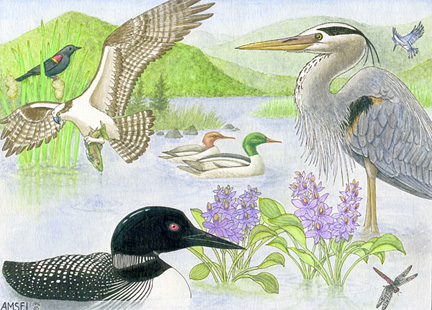

Until recently, wetlands were thought to be of no use to man. Wet and buggy, they were considered wasted land. Developers drained them, filled them in with tons of soil and built houses, businesses, schools and parking areas on them.
Then scientists began to realize the important role wetlands played in the environment. During a storm a wetlands is like a giant sponge. It soaks up extra storm water and afterward they release it very slowly. This is a great help to prevent flooding. In communities where wetlands have been drained, the streets and homes are often flooded during a big storm with no wetlands to soak up all the extra storm water.
Wetlands can filter pollutants out of the environment by absorbing excess nutrients, like phosphorus and nitrogen, and dissolving it over time. Though wetlands can become polluted when wastewater and fertilizer from farm fields are allowed to flow into them, they are able to process some pollutants over time because of all the microorganisms and plants living there.
Wetlands are also homes to millions of breeding birds, fish and amphibians around the world.
Now that people realize how important wetlands are the EPA (Environmental Protection Agency) has made regulations in the Clean Water Act to protect them. Many wetlands have become national wildlife refuges, where you can go to take pictures and look at birds and animals.
You can support wetlands by joining your local chapter of the Nature Conservancy or other environmental protection organization and helping with clean up days. People tend to dump garbage in wetlands where animals can be injured by it. Support your local bird refuge.
(Included in PDF Above)
The Importance of Wetlands - Read and React
1. Why did people used to drain wetlands?
2. Name three important roles of wetland:
3. Name the EPA (Environmental Protection Agency) regulation that is mean to protect wetlands:
4. How can individuals like you help support wetlands?
5. Name one animal you might find in a wetland:
When you research information you must cite the reference. Citing for websites is different from citing from books, magazines and periodicals. The style of citing shown here is from the MLA Style Citations (Modern Language Association).
When citing a WEBSITE the general format is as follows.
Author Last Name, First Name(s). "Title: Subtitle of Part of Web Page, if appropriate." Title: Subtitle: Section of Page if appropriate. Sponsoring/Publishing Agency, If Given. Additional significant descriptive information. Date of Electronic Publication or other Date, such as Last Updated. Day Month Year of access < URL >.
Amsel, Sheri. "Wetlands - Their Important and Why" Exploring Nature Educational Resource ©2005-2024. December 13, 2024
< http://exploringnature.org/db/view/1803 >
